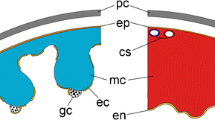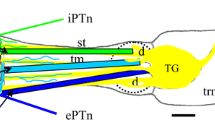Summary
Using serial-sectioning techniques for conventional transmission and high-voltage electron microscopy, we characterized the ultrastructural features and synaptic contacts of the sensory cell in tentacles ofHydra. The sensory cell has an apical specialization characterized by a recessed cilium surrounded by three rodlike stereocilia. This ciliary—stereociliary complex constitutes the receptive or dendritic pole of the sensory cell. The dense filamentous cores of the stereocilia project proximally into a narrow circumciliary cytoplasmic region connected by septate junctions to marginal processes of an enveloping epitheliomuscular cell. The central cilium has a characteristic marginal flare midway along its length and a dense filamentous substructure at its base. Pairs of branched, striated rootlets extend from the axial centriole into a mitochondria-rich region of the cell. Pigment-like granules are present in the cytoplasm around the circumciliary space. The perikaryon is characterized by an elongate nucleus surrounded by a narrow rim of cytoplasm containing prominent Golgi complexes, assorted vacuoles and dense-cored vesicles, free ribosomes, short segments of rough endoplasmic reticulum, microtubules, glycogen particles, and lipid droplets.
Generally, one or two thin, naked axons extend laterally from the perikaryon into the nerve net region above the myonemes of the large epitheliomuscular cells. Within the axons are found occasional aggregates of dense-cored vesicles anden passant synapses characterized by the presence of clear or dense-cored vesicles in contact with paramembranous densities and associated intracleft cross filaments. Using these ultrastructural criteria, we demonstrated for the first time that the granule-containing sensory cells have synaptic contacts with other neurons, nematocytes, and epitheliomuscular cells; hence, we considered these cells to be sensory–motor–interneurons with neurosecretory granules. We hypothesize that this unique, apparently multifunctional neuron may be a modern representative of a primitive stem cell that gave rise evolutionarily to the sensory cells, motor neurons, interneurons, and neurosecretory cells of higher animals.
Similar content being viewed by others
References
Atwood, H. L. (1976) Organization and synaptic physiology of crustacean neuromuscular systems.Progress in Neurobiology 7, 291–391.
Campbell, R. D., Josephson, R. K., Schwab, W. E. andRushforth, N. B. (1976) Excitability of nerve-free hydra.Nature 262, 388–90.
Davis, L. E., Burnett, A. L. andHaynes, J. F. (1968) Histological and ultrastructural study of the muscular and nervous systems inHydra II. Nervous system.Journal of Experimental Zoology 167, 295–332.
Eakin, R. M. (1972) Structure of invertebrate photoreceptors. InHandbook of Sensory Physiology, Vol. VII/1 (edited byDartnall, H. J. A.), pp. 625–84. Berlin, Heidelburg, New York: Springer-Verlag.
Elias, P. M., Park, H. D., Patterson, A. E., Lutzner, M. A. andWetzel, B. K. (1972) Osmium tetroxide-zinc iodide staining of Golgi elements and surface coats of Hydras.Journal of Ultrastructure Research 40, 87–102.
Estable-Puig, J. F., Bauer, W. C. andBlumberg, J. M. (1965) Paraphenylenediamine staining of osmium-fixed, plastic-embedded tissue for light and phase microscopy.Journal of Neuropathology and Experimental Neurology 24, 531–5.
Hadži, J. (1909) Über das Nervensystem von Hydra.Arbeiten Zoologische Institüt der Universität Wien 17, 225–68.
Hudspeth, A. J. andCorey, D. P. (1977) Sensitivity, polarity, and conductance change in the response of vertebrate hair cells to controlled mechanical stimuli.Proceedings of the National Academy of Sciences of the United States of America,74, 2407–11.
Hufnagel, L. andKass-Simon, G. (1976) The ultrastructural basis for the electrical coordination between epithelia ofHydra. InCoelenterate Ecology and Behavior (edited byMackie, G. O.), pp. 695–704. New York, London: Plenum Press.
Kandel, E. R. (1976)Cellular Basis of Behavior. San Francisco: W. H. Freeman and Co.
Lentz, T. L. (1965)Hydra: Induction of supernumerary heads by isolated neurosecretory granules.Science 150, 633–5.
Lentz, T. L. (1968)Primitive Nervous Systems. New Haven, London: Yale University Press.
Lentz, T. L. andBarrnett, R. J. (1965) Fine structure of the nervous system ofHydra.American Zoologist 5, 341–56.
Macklin, M. (1976) The effect of urethane on Hydra.Biological Bulletin 150, 422–52.
Parker, G. H. (1919)The Elementary Nervous System. Philadelphia, London: Lippincott.
Peteya, D. J. (1973) A possible proprioceptor inCeriantheopsis americanus (Cnidaria, Ceriantharia).Zeitschrift für Zellforschung und mikroskopische Anatomie 144, 1–10.
Sato, T. (1968) A modified method for lead staining of thin sections.Journal of Electron Microscopy (Tokyo),17, 158.
Schaller, H. C. (1973) Isolation and characterization of a low-molecular-weight substance activating head and bud formation in hydra.Journal of Embryology and experimental Morphology 29, 27–38.
Schaller, H. C. (1976) Action of the head activator as a growth hormone in hydra.Cell Differentiation 5, 1–11.
Schaller, H. andGierer, A. (1973) Distribution of the head-activating substance in hydra and its localization in membranous particles in nerve cells.Journal of Embryology and experimental Morphology 29, 39–52.
Scharrer, B. andWeitzman, M. (1970) Current problems in invertebrate neurosecretion. InAspects of Neuroendocrinology (edited byBargmann, W. andScharrer, B.) pp. 1–23. Berlin, Heidelburg, New York: Springer-Verlag.
Schneider, K. C. (1890) Histologie vonHydra fusca mit besonderer Berücksichtigung des Nervensystems der Hydropolypen.Archiv für mikroskopische Anatomie,35, 321–79.
Tardent, P. andWeber, C. (1976) A qualitative and quantitative inventory of nervous cells inHydra attenuata Pall. InCoelentrate Ecology and Behavior (edited byMackie, G. O.) pp. 501–12. New York, London: Plenum Poess.
Venable, J. H. andCoggeshall, R. (1965) A simplified lead citrate stain for use in electron microscopy.Journal of Cell Biology 25, 407–8.
Westfall, J. A. (1973a) Ultrastructural evidence for a granule-containing sensory-motor-interneuron inHydra littoralis.Journal of Ultrastructure Research 42, 268–82.
Westfall, J. A. (1973b) Ultrastructural evidence for neuromuscular systems in coelenterates.American Zoologist 13, 237–46.
Westfall, J. A. andKinnamon, J. C. (1977) Synaptic foci ofHydra sensory cells.American Zoologist 17, 923.
Westfall, J. A., Yamataka, S. andEnos, P. D. (1970) Ultrastructure of synapses inHydra.Journal of Cell Biology 47, 226a.
Westfall, J. A., Yamataka, S. andEnos, P. D. (1971) Ultrastructural evidence of polarized synapses in the nerve net ofHydra.Journal of Cell Biology 51, 318–23.
Author information
Authors and Affiliations
Rights and permissions
About this article
Cite this article
Westfall, J.A., Kinnamon, J.C. A second sensory—motor—interneuron with neurosecretory granules inHydra . J Neurocytol 7, 365–379 (1978). https://doi.org/10.1007/BF01176999
Received:
Revised:
Accepted:
Issue Date:
DOI: https://doi.org/10.1007/BF01176999




